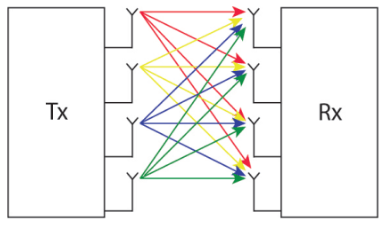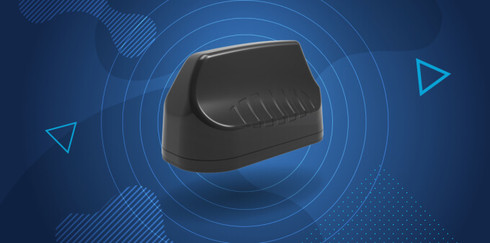MIMO Antennas: Key to Supercharging Cellular Router Connectivity
MIMO technology creates more stable and reliable WiFi and cellular networks, making it a huge boon to wireless communication. For those who use MIMO-capable cellular routers, cellular modems, and hotspots, getting a MIMO antenna can take your connectivity experience to the next level. Keep reading to learn how.
Take advantage of our system design and installation services. Learn more or call us for a free consultation: 1-800-969-8189.
What is MIMO?
MIMO stands for multiple input, multiple output. It’s a wireless technology that uses multiple transmitting and receiving antennas to improve data transfer reliability and speed.
There are multiple MIMO configurations. The most common are:
- 2X2 MIMO – Features two transmitting and two receiving antennas.
- 4X4 MIMO – Features four transmitting and four receiving antennas.
- 6X6 MIMO – Features six transmitting and six receiving antennas.
- 8X8 MIMO – Features eight transmitting and eight receiving antennas.
MIMO-enabled devices send out the same data as several signals via all their transmitting antennas. As the different signal streams travel over the air to reach their destination, noise and obstacles can interfere with their strength, speed, and path.
Each antenna at the receiver is able to receive and combine the different signal streams coming in at different times and angles. This decreases signal latency and loss, which increases speed and reliability.

You can find MIMO technology built into WiFi and cellular devices. Integrating MIMO antennas, if possible, helps improve MIMO-enabled equipment performance if needed.
What Are MIMO Antennas?
MIMO antennas are antennas specially designed to send and receive multiple data streams at the same time. There are cellular MIMO antennas and WiFi MIMO antennas. Some MIMO cellular routers and hotspots have internal cellular and WiFi antennas, while others have external ones.
In many cases, the antennas built-in or supplied with your cellular router or hotspot are not powerful enough to provide you with the results you desire. RF noise, tall structures, building material, and distance from cell towers prevent the antennas from capturing and broadcasting the strongest signals possible.
There are many MIMO antennas in the market for MIMO-enabled devices with antenna ports that can significantly improve connectivity.
Cellular MIMO Antennas
Cellular MIMO antennas, typically installed outdoors, are more powerful and will deliver a stronger cellular signal to your cellular router. They can be directional or omnidirectional.
Directional MIMO antennas feature more gain, making them the best option for weak signal areas. For best results, they must point in the direction of your carrier's closest cell tower.
Omnidirectional MIMO antennas capture cellular signals from every direction. While not as powerful as directional MIMO antennas, they are much easier to install and better at communicating with different carrier cell towers. They are best for areas with moderate to strong cellular signals and cellular routers using different carrier SIM cards.
WiFi MIMO Antennas
WiFi MIMO antennas, typically installed inside, let you improve your WiFi coverage. Upgrading WiFi MIMO antennas is less common as not all cellular routers and hotspots on the market have indoor WiFi antenna ports.
There are directional and omnidirectional options. The directional WiFi MIMO antennas broadcast signal in one direction, while the omnidirectional WiFi MIMO antennas broadcast signal in every direction.
What Are the Advantages of MIMO Antennas?
Using the right MIMO antenna for your situation helps:
- Get you faster speeds
- Enables stronger signal
- Finetune received signal
- Minimize RF noise interference
- Improve visual and auditory quality
- Reduce latency
- Provide a better connectivity experience
- Enhance reliability
Where Can I Use a MIMO Antenna?
Depending on the MIMO antenna specs, they can be used inside or outside a wide range of applications. This includes:
- Homes
- Offices
- Commercial Buildings
- Cars
- Trucks
- RVs
- Semis
- Boats
What are the Best MIMO Antennas?
Bolton Technical Crossbow 5G
Best for:
- Homes & commercial buildings.
- Areas with poor cellular signal.
- Environments with distant cell towers.
- 2X2 MIMO cellular router, modems, and hotspots.
The Crossbow 5G is a directional cross-polarized 2X2 MIMO antenna designed for cellular broadband routers, modems, and hotspots.
This antenna features up to 11 dBi of gain, allowing it to communicate with cell towers located up to 5 miles away. This makes the Crossbow perfect for environments where cell towers are far and cell signal is weak. When tested, we saw significant improvements in upload and download speeds in an area with extremely poor cellular reception. It works with 4G and 5G signals across the 617-3800 cellular frequencies, ensuring you get the best of the best.
The Crossbow is available in two versions. The most popular version includes a 16 ft Twin HDF-195 cable with SMA-Male connectors. Great for SMA-Female cellular routers or hotspots, as well as TS-9 routers or hotpots with the use of an adapter. The second version comes with twin N-Female ports without cables, allowing you to choose a longer cable for long cable runs.
Poynting XPOL-1-5G
Best for:
- Apartments, homes, and offices.
- Areas with moderate to strong cellular signal.
- 2X2 or 4X4 cellular routers, modems, and hotspots.
The Poynting XPOL-1-5G looks like the Bolton Crossbow, but it's smaller and not as powerful. Rather than capturing cellular signals from a single direction, it has an omnidirectional radiation pattern. It’s ideal for areas with decent signals. If there is a lot of RF noise, it will help finetune connectivity. Wideband with peak gains of 3.5 dBi, you’ll receive increased performance across frequency bands 617-3800 MHz. You can easily mount it on a pole or even a window via suction cups, making it renter friendly. 2X2 and 4X4 MIMO options available.
Poynting XPOL-24 5G
Best for:
- Homes & commercial buildings.
- Areas with poor cellular signal.
- Environments with distant cell towers.
- 4X4 MIMO cellular router, modems, and hotspots.
The directional Poynting XPOL-24-5G is as powerful as the Bolton Crossbow, just bigger. It houses four receiving antennas and four transmitting antennas. It’ll work with 4X4 cellular MIMO routers receiving poor signal due to cell tower distance. Designed to capture all cellular signals within the 617-4200 MHz bandwidths, this antenna will deliver superior 4G and 5G reception to your router.
Poynting OMNI-600
Best for:
- Homes, offices, RVs, and boats.
- Areas with weak to strong cellular signals.
- Capturing cellular signals from all directions.
- 2X2 MIMO cellular router, modems, and hotspots.
The Poynting OMNI-600 is a high performing omnidirectional 2X2 MIMO antenna. It receives 4G/LTE/5G cellular signals operating across 410 to 3800 MHz from every direction. No need to point it at your closest cell tower for optimal results. Built with up to 6.2 dBi of gain, it ensures a faster connection. Versatile, the OMNI-600 can be used to enhance your home, office, RVs, and boats. Just over two feet tall, it rises above surrounding obstacles for best results.
Poynting PUCK
Best for:
- Urban, suburban, and rural driving.
- Cars, trucks, RVs, and semis.
- In-vehicle cellular router applications.
- 2X2 cellular routers.
The Poynting PUCK is a high-performing omnidirectional antenna. 2X2 MIMO options available. It fits any vehicle, from cars, to RVs, to fleets. Small and sleek design ensures antenna does not stand out. With gains up to 7.5 dBi, it works where many other vehicle omnidirectional antennas can’t. It can be magnet-mounted, hard-mounted, or pole mounted.
The 2X2 PUCK 2 delivers stronger cellular signals to your cellular router, increasing WiFi performance. The 2X2 PUCK 12 helps maximize WiFi reception and coverage. If you’d like a PUCK that features MIMO cellular antennas and MIMO WiFi antennas in a signal housing, the PUCK 5 is the way to go. Though, it will broadcast WiFi signals outside, making it ideal for RVers.
Poynting MIMO
Best for:
- Urban, suburban, and rural driving.
- RVs and semis.
- In-vehicle cellular router applications.
- 2X2 or 4X4 cellular routers
The Poynting MIMO antenna also fits any vehicle type. Though, it is best for large vehicles, like RVs and semis as it is much bigger than the PUCK. There are different configurations available for different applications.
If you just want to enhance your cellular router to receive the strongest signal possible, go for the 2X2 LTE MIMO 3-12 or 4X4 LTE MIMO 3-14. To optimize both cellular and WiFi with a single antenna, consider the 2X2 LTE/WiFi MIMO 3-15 or 4X4 LTE/2x2 WiFi MIMO 3-17. Keep in mind that these will broadcast WiFi signals outside.
The offer up to 6.2 dBi gain for cellular and 7 dBi gain for WiFi. You can magnet mount or hard-mount them.
Poynting EPNT X-POL
Best for:
- Urban, rural, commercial, and marine applications.
- 2X2 or 4X4 cellular routers.
- Housing a cellular router.
The Poynting EPNT X-POL antenna is a 4X4 or 2X2 MIMO 5G/LTE and WiFi antenna. Both versions come with a GPS antenna. Unique design allows you to house a small router (5.5 in x 4.7 in x 1.9 inches) inside the enclosure. This results in less cabling and greater performance. Rugged, it can be used for urban, rural, commercial, and marine applications.
Should I Get A MIMO Antenna or a Cell Phone Signal Booster?
MIMO antennas are a phenomenal way to increase your internet connection when using cellular hotspots and routers that have external antenna ports. You can easily connect a 2X2 or 4X4 MIMO antenna and improve the signal reaching the router in strong and poor cell signal areas.
The only way to get a better signal to a cellular hotspot or router without antenna ports is with a cell phone signal booster. They capture your existing outside cell signal and deliver it even stronger inside your home, office, or vehicle. Your cellular hotspot or router will automatically pick up the boosted signal and deliver greater results. In addition to improving cellular to WiFi performance, they also boost voice and text. Dropped calls and undelivered texts will be a thing of the past.
In most cases, MIMO antennas will deliver greater speeds than a cell phone signal booster. This is because cell phone boosters use SISO (single input, single output) antennas. Since they can only transmit one data signal and receive one data signal at a time, they do not maximize data performance.
When used together, though, you can get the best of both worlds.
Signal Boosters is a leading provider of MIMO antennas, cellular routers, and cell phone signal boosters. We can help you build the best cellular wireless broadband configuration for your needs. Give us a call at 1-800-470-6777 or email us at info@signalboosters.com to get started.
Interested in Learning More? Check Out Our Cellular Info Hub / WiFi Info Hub












